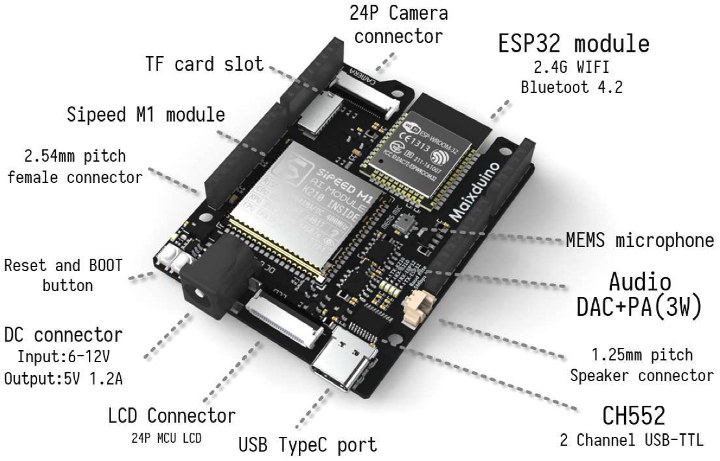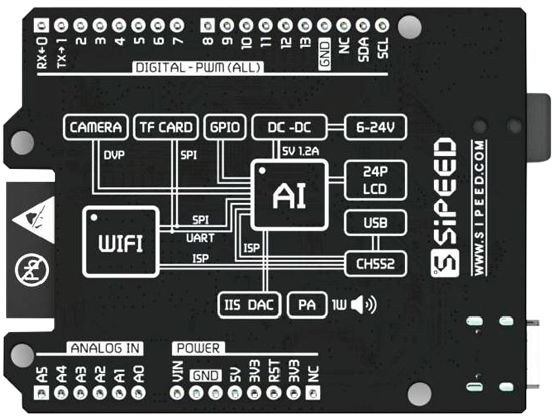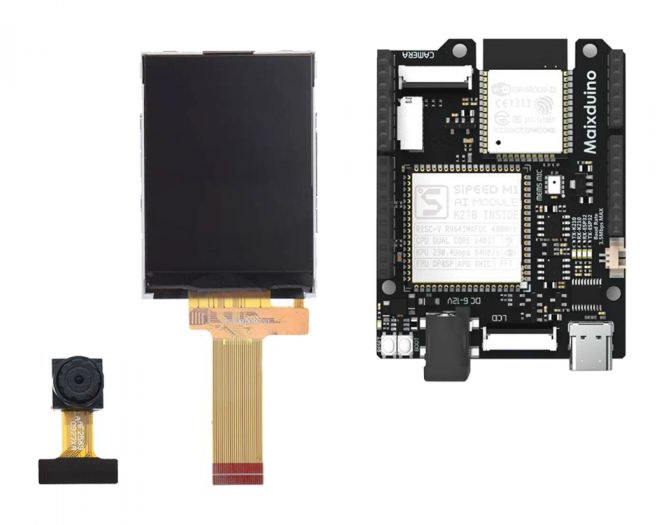Last year RISC-V cores made it into low-cost hardware with neural network and audio accelerator to speed up artificial intelligence workloads at the edge such as object recognition, and speech processing. More precisely, Kendryte K210 dual-core RISC-V processor was found in Sipeed MAIX modules and boards going for $5 and up.
Since then a few other variants and kits have been made available including Seeed Studio Grove AI HAT that works connected to a Raspberry Pi or in standalone mode. Seeed Studio has now released another board with Kendryte K210 RISC-V AI processor, but based on Arduino UNO form factor and equipped with an ESP32 module for WiFi and Bluetooth connectivity. Meet Sipeed Maixduino SBC.

Sipeed Maixduino specifications:
- AI Module – Sipeed M1 with Kendryte K210 dual-core RISC-V processor @ 600 MHz, KPU Convolutional Neural Network (CNN) hardware accelerator, APU audio hardware accelerator, 8 MB general purpose SRAM including 5.9MB usable as AI SRAM memory
- Wireless Module – Espressif Systems ESP32-WROOM-32 with dual-core ESP32 Xtensa LX6 processor, 2.4GHz 802.11.b/g/n WiFi 4, and Bluetooth 4.2 LE connectivity
- Storage – microSD card slot
- Camera I/F – 24-pin DVP camera connector
- Display I/F – 24-pin LCD connector for 8-bit MCU LCD display
- Audio – Built-in MEMS microphone; TM8211 I2S audio DAC, 3W power amplifier, 1.25mm pitch speaker connector
- USB – 1x USB 2.0 Device type C for power and programming via dual channel CH522 chip to support for both K210 and ESP32
- Expansion – Arduino UNO compatible headers with digital I/Os / PWM, I2C, UART, 6x analog inputs, and power signals
- Misc – Boot & reset buttons
- Power Supply
- Input
- 6 to 12VDC via power barrel jack
- 5V via USB-C port
- Output – 5V DC up to 1.2A
- Input
- Dimensions – Arduino UNO form factor
- Temperature Range – -30°C to 85°C

Maixduino can be programmed with MaixPy IDE (MicroPython), Arduino IDE, OpenMV IDE, and PlatformIO IDE, and supports Tiny-Yolo, Mobilenet and TensorFlow Lite deep learning frameworks with QVGA @ 60fps or VGA @ 30fps image identification. You’ll find a work-in-progress microsite with documentation here.
Typical applications would include smart home (robot cleaners or smart speakers), medical devices, factory 4.0 (intelligent sorting or monitoring of electrical equipment), as well as agriculture, and education.
Maixduino development board is sold for $23.90 plus shipping as part of a kit that includes an OV2640 camera module and a 2.4-inch TFT display. Shipping is expected by the end of the month (May 2019).

Jean-Luc started CNX Software in 2010 as a part-time endeavor, before quitting his job as a software engineering manager, and starting to write daily news, and reviews full time later in 2011.
Support CNX Software! Donate via cryptocurrencies, become a Patron on Patreon, or purchase goods on Amazon or Aliexpress





